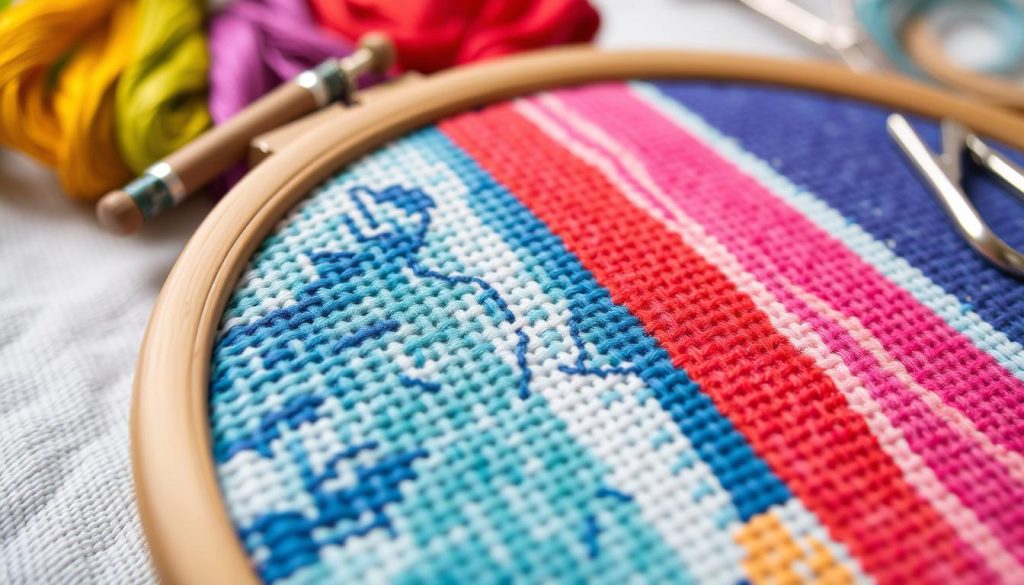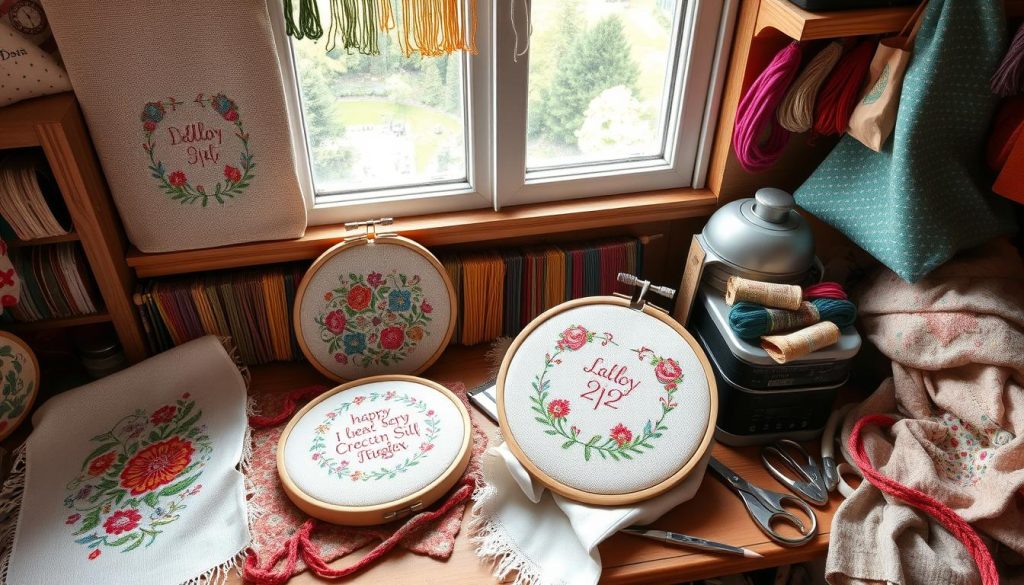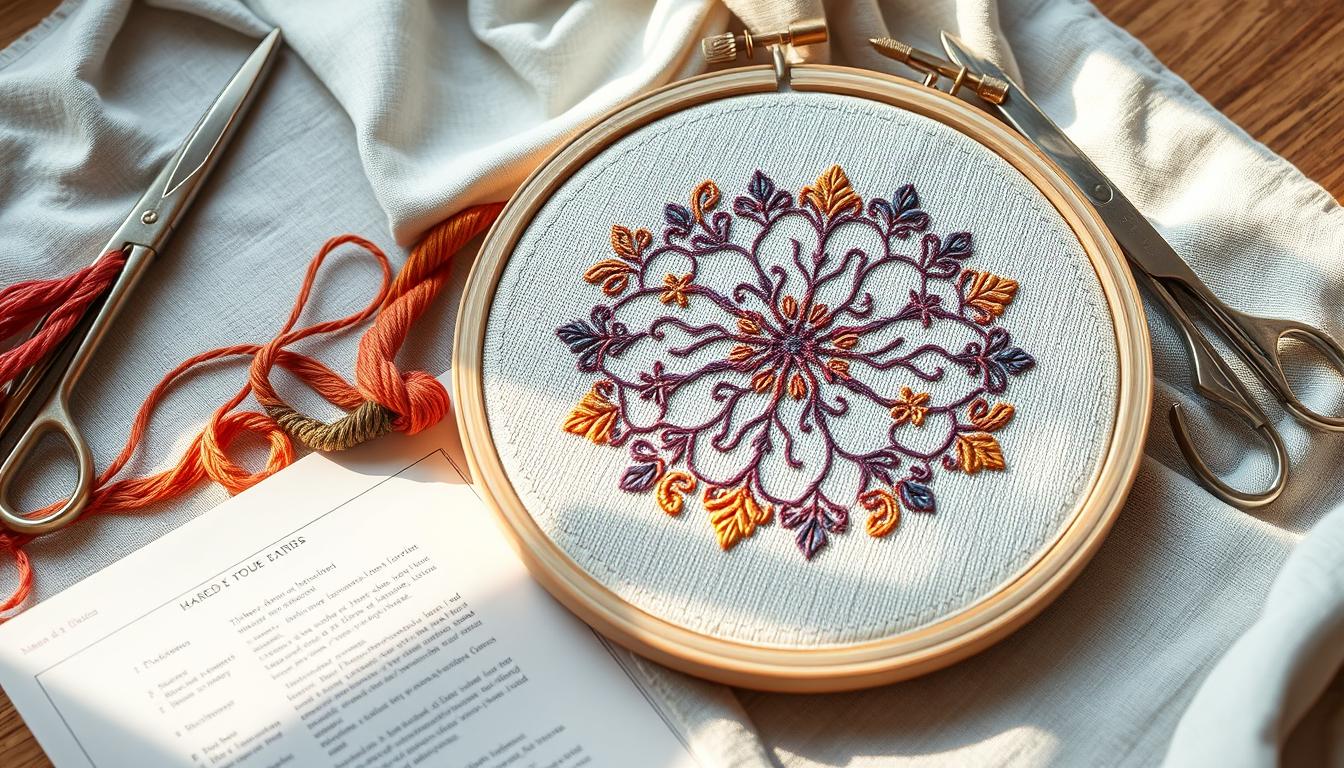Choosing whether to use a hoop for cross stitch depends on your personal taste, the project details, and your stitching methods. Both options have their own advantages and disadvantages. This article will dive into these differences to help you decide what works best for you.
Understanding these differences can guide you in choosing the right method. It should match your stitching style, the fabric you’re working with, and your comfort level.
Key Takeaways
- Stitching without a hoop can be 50% faster than the traditional “stab” method.
- A common misconception is that the sewing method is only ideal for large blocks of color.
- Roughly 50% of participants reported positive experiences without using hoops due to better tension control.
- About 45% of participants preferred hoops or frames to alleviate issues like arthritis and wrist pain.
- Popular hoop and frame brands include Elbesee, Luca-S, Siesta, Millenium, and Qsnap.
Introduction to Cross Stitching With and Without a Hoop
Cross stitching is a fun and versatile art that has been loved by many for years. It doesn’t matter if you’re new or experienced; knowing how to use a hoop can make a big difference. This guide will cover the basics of both methods, showing you the good points of each.
Starting your beginner cross stitch adventure means deciding if you’ll use a hoop. Hoops, made of wood or plastic, help keep your stitches even. For newbies, using a hoop is a good idea because it makes it easier to control your fabric.
Beginner patterns usually have 3 to 10 colors, making them easy to follow. These patterns are also affordable, costing between $5 and $15. A 14 count Aida fabric is recommended for beginners. It has 11 or 14 holes per inch, perfect for detailed designs.
Hoops are great for intricate designs that need precise tension. But, some experienced stitchers like working without a hoop. This lets them move faster and adjust their techniques as needed.
The type of embroidery floss you use is also important. Most floss has six strands that need to be separated. Beginners should use about 18 inches of floss to avoid tangling. It’s suggested to stitch from left to right, starting in the middle of the fabric.
To help beginners, most patterns include suggested DMC colors for the thread. This makes it easy to start your project. To finish the threads, weave them under at least three stitches at the back of your work.
| Aspect | With a Hoop | Without a Hoop |
|---|---|---|
| Control and Tension | Better for maintaining consistent tension | May have varied tension control, but offers more flexibility |
| Speed | May be slower for some | Generally faster for seasoned stitchers |
| Beginner Friendly | Highly recommended | Not usually recommended for beginners |
| Fabric Integrity | Maintains fabric tension, reducing puckering | Requires careful handling to avoid fabric distortion |
Whether you use a hoop or not depends on your project’s needs and your preference. Both methods have their own advantages. Knowing these will help you create beautiful cross stitch designs with confidence.
The Benefits of Using a Hoop in Cross Stitching
Using a hoop in cross stitching has many benefits. One big plus is keeping consistent tension in your stitches. This makes your work look professional. Hoops are also affordable and easy to find, making them a favorite among stitchers.

Hoops come in sizes from 3 to 12 inches, and even bigger for quilting. You can find the right size for any project. They come in shapes like round, oval, and square, giving you flexibility.
Wooden hoops, especially those made from beechwood, are great because they’re sturdy and comfortable. Modern options like plastic clip frames, like Q-Snaps, are also popular. They keep the fabric tight and are good for big projects.
For beginners, a cross stitch hoop is very helpful. It keeps the fabric tight, making it easier to stitch. This makes learning easier. With hoops, you can try different cross stitch fabrics and cross stitch tips to find your style.
Hoops are versatile, easy to use, and help keep consistent tension. They’re a must-have for cross stitching.
The Downsides of Using a Hoop
Using a hoop can help with cross-stitching, but it has its own problems. About 15% of hoops can leave marks on fabric, especially if left on for too long. This might mean you need to iron your fabric after you’re done to get rid of wrinkles.
Hoops can also limit the size of your projects. For bigger or more detailed patterns, around 20% of embroiderers find hoops too small. This means they have to keep moving the hoop, which can break your stitching flow.
Another issue is that using hoops a lot can change the fabric’s tension and count. Over time, hoops can stretch the fabric, altering its count and even damaging stitches. Users on forums have talked about how frames can be tighter than hoops, making it important to adjust them carefully.
Dirt can also be a problem. Fabric stretched in a hoop can trap dirt, making it hard to finish your cross stitch. Taking off the hoop after you’re done can help, but it’s not always enough.
About 25% of experienced embroiderers now use hoopless frames or stands instead. They choose based on their project and what they like. Tips include using plastic hoops or wrapping hoops with bias tape to avoid fabric distortion. There’s also talk about how to fix fabric creases and remove stains if they get stuck.
| Issue | Impact | Solution |
|---|---|---|
| Fabric Creases and Wrinkles | 15% of hoops leave marks, requiring ironing | Remove hoop after use, use larger hoops |
| Size Limitations | 20% find hoop size restricts patterns | Frequent repositioning, use adaptable frames |
| Tension and Tightness | Can stretch fabric, alter count, crush stitches | Regular adjustment, adopt hoopless methods |
| Dirt Accumulation | Dirt settles in stretched parts of fabric | Remove hoop when not stitching, regular cleaning |
Understanding Cross Stitching Without a Hoop
Stitching without a hoop, or “stitching in hand,” is a flexible way to do cross stitch. It lets you move naturally over the fabric. This makes stitching faster, especially on big areas of color.

This method is great for moving easily around complex designs. But, it can be hard to keep the right tension. You need to focus on keeping the thread tight, not the fabric.
Many people love stitching in hand for its freedom. It’s perfect for big projects that change direction a lot. This method lets you work freely.
Both Aida and evenweave fabrics work well without a hoop. Aida is good for beginners because of its grid. Evenweave gives a finer look for those who want to improve their skills. The key is to keep the tension even for even stitches.
When starting a new thread, don’t knot it. This keeps your stitching smooth and fast. Always finish one section before starting another to avoid long jumps.
Stitching can also help reduce stress and anxiety. Many find it calming and beneficial for their mental health. With free patterns available, there’s always something new to try.
However, stitching without a hoop can be tiring for your hands. It’s especially true if you’re new to it. But, with practice, you’ll get better and find your own way to manage projects.
In short, stitching in hand is great for big and detailed projects. It’s challenging at first, but with patience and practice, it becomes rewarding.
Comparing Methods: Cross Stitching With and Without a Hoop
When you compare cross stitching with and without a hoop, several things matter. These include how your stitches look, their quality, and how fast and efficient you are. A hoop can make your stitches look better, especially for detailed designs. But, stitching without a hoop can make simpler or bigger projects faster.
Comfort and ease also play a big role. Some people find hoops hard to handle, while others like how stable they are. Let’s dive deeper into both methods to help you decide for your next project:
| Method | Advantages | Disadvantages |
|---|---|---|
| With a Hoop |
|
|
| Without a Hoop |
|
|
In the end, whether you use a hoop or stitch by hand, knowing the differences is key. It helps you find the right balance between speed and efficiency and the quality of your work. Try both ways to see which fits your style and needs best.
Choosing the Right Tools: Hoops, Q-Snaps, and Frames
The tools you pick for cross stitch can really change your experience and the look of your work. There are many options, so knowing the good and bad of each is key to making a smart choice.
Hoops: These classic tools are great for beginners because they keep the fabric tight. They come in wood or plastic. But, 40% of people say they can be tricky, especially when the fabric slips. Still, they’re a good start for beginners because they’re easy to use.
Q-Snap Frames: These modern tools are loved by 60% of users, more than hoops. They come in sizes like 8″x8″ and 11″x11″. They grip well and adjust easily. Sizes like 6×6, 9×9, 11×11, and extension kits let you customize. They keep the fabric tight without needing to adjust often, making them great for all skill levels.
Frames: For big projects, frames keep the fabric tight for a long time. They fit more fabric, perfect for big designs. Using a stand makes stitching better by letting you work without holding the fabric. Now, there are stands that adjust to fit your needs, like height and angle.
To get the best from your tool, follow some tips. Add 2-4 inches to your fabric size for projects. Use fabric guards to keep your material clean. Picking the right tools and accessories will make your crafting better and your projects look great.
Conclusion
Choosing to cross stitch with or without a hoop depends on your personal taste and project needs. Both methods have their own benefits and challenges. By trying both, you can find what works best for you and your project.
Using a hoop can help with tight designs and modern patterns. But, stitching without one lets you connect more with your fabric. This can give your cross stitch a unique, personal touch.
Think about your fabric, project size, and comfort when picking tools. Hoops, Q-snaps, and frames each have their uses. Not using a hoop can also save money and simplify your setup. Cross stitch kits and supplies are affordable, making it easy to experiment.
Cross stitching, with or without a hoop, is a fulfilling hobby. Mistakes can fade in the final piece, especially for smaller projects. Enjoy the process and create cross stitch pieces that reflect your style.
